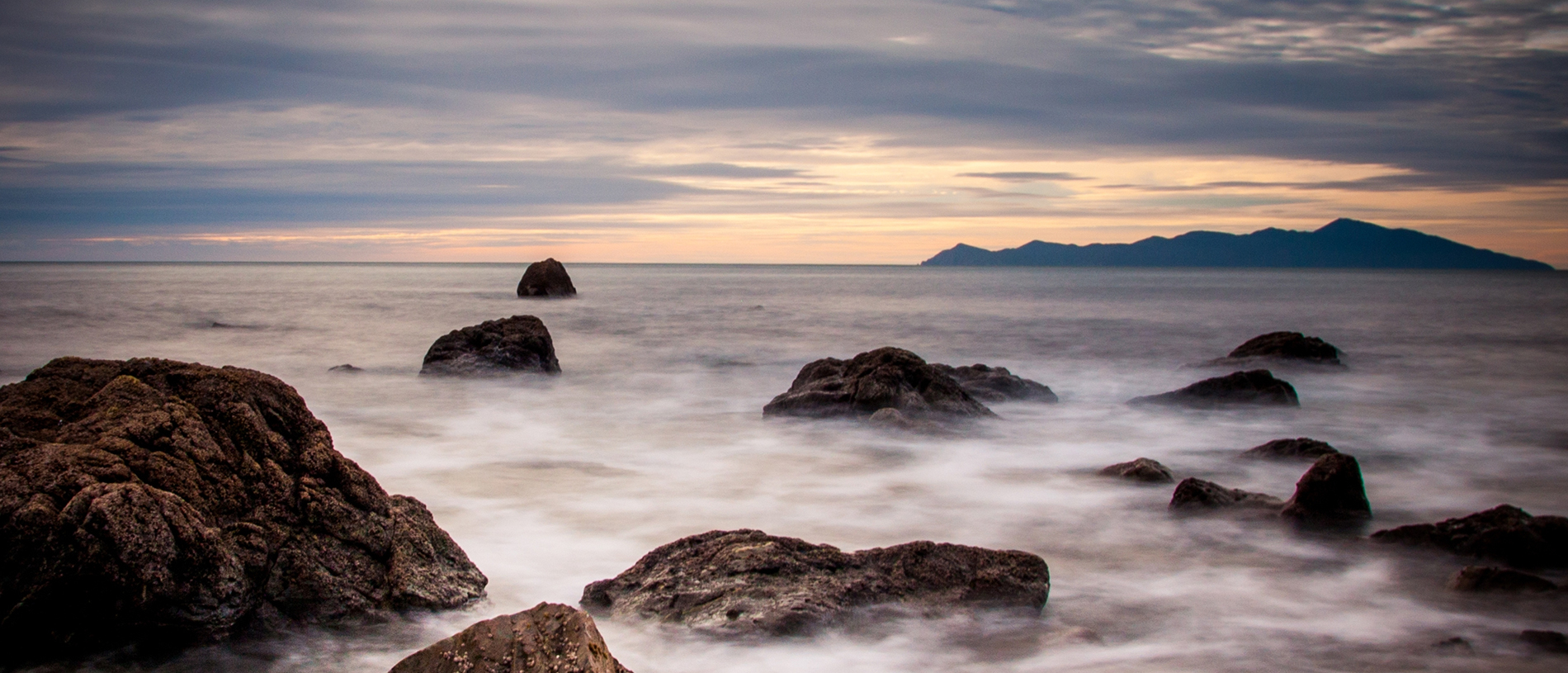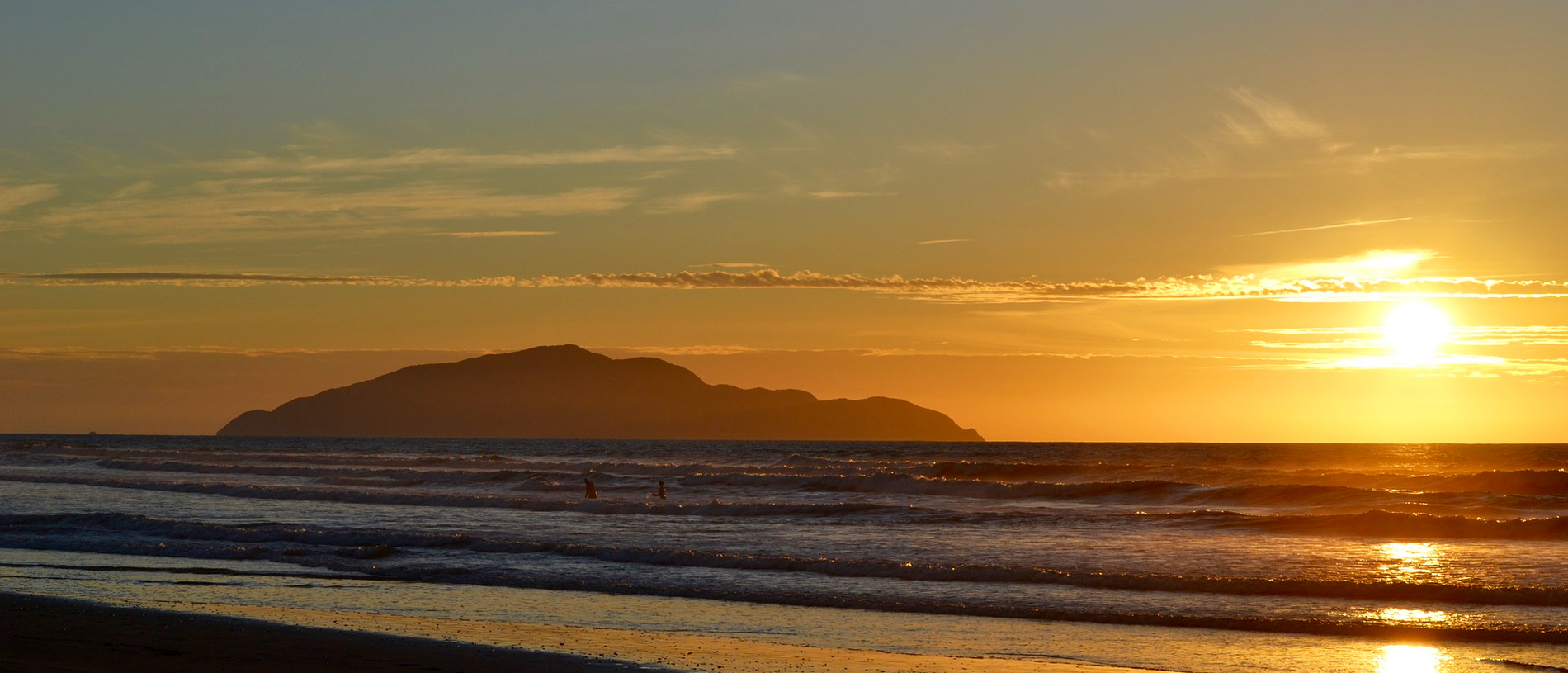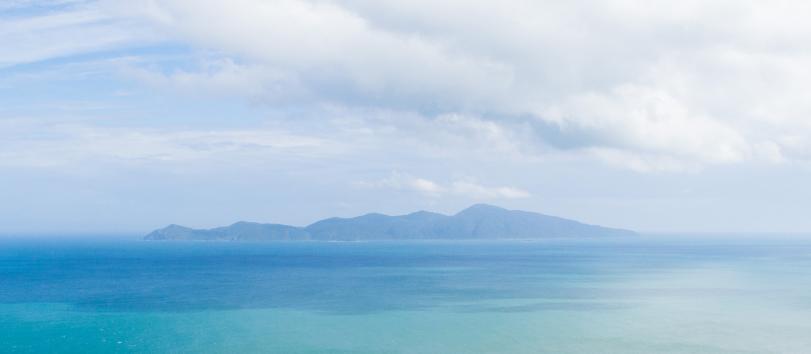
Kāpiti Island: birds of paradise
Lying only 15 minutes off Paraparaumu by boat and only 90 minutes north of Wellington by road, Kāpiti Island is New Zealand’s most accessible offshore wildlife sanctuary.

Those who live on the Kāpiti Coast will tell you it’s a place to die for.
The comparatively benign climate, the lovely beaches and the matchless views have made Kāpiti the lower North Island’s retirement destination. But there's much more to Kāpiti than an ageing population.
Viewed from the south, the Kāpiti Coast begins (roughly speaking) where the frowning bluffs of Paekākāriki Hill retreat from the shoreline somewhat and habitable land resumes.
The same forces that so attractively pleated the lower North Island also bestowed upon the district its most distinctive feature: namely, the high, brooding silhouette of Kāpiti Island around five nautical miles off the coast.

Kāpiti Island is the visible remains of a range of mountains that reared to the west to keep the Tararuas company, but which have since been all but drowned and cut off from the mainland. But the combined effect of Kāpiti out there to the west and the Tararuas to the east is to shelter the coast and its hinterland from the worst effects of the wind. The micro-climate thus formed – it’s sometimes called ‘the blue sky circle’ – keeps the coast around two to three degrees warmer than Wellington to the south or Horowhenua to the north.
For this reason, the Kāpiti Coast has a long history of human habitation. Māori have occupied the district for just about as long as they’ve occupied any other part of New Zealand: the rivers with their estuaries, the wetlands inland and the stands of lowland podocarp forest that studded the floodplains were teeming with fish, shellfish, eels and birds.
By the time Europeans had arrived, the area was firmly under the control of Ngāti Toa, invaders from the Kāwhia district well to the North. Their great rangatira, Te Rauparaha, proved to be an early adopter of European technologies, most notably the musket. He wasted no time in trading access to the local abundance of flax and whales to the pākehā in return for the chance to tool up and make life miserable for much of the rest of the Tangata Whenua, particularly Ngāi Tahu to the South. Basing himself on Kāpiti Island, which proved impregnable under his dominion, Te Rauaparaha carried out a succession of bloody raids upon his hapless southern neighbours, as far south as Banks Peninsula.
His work at Akaroa was his most notorious: he hired a small European sailing vessel, complete with captain and crew, to conduct a sneak attack on Ngāi Tahu. He slaughtered the local population and packed their remains into picnic baskets in order to perform cannibal victory rites upon his return to Kāpiti. Also aboard were the Ngāi Tahu rangatira, Tama-i-hara-nui and his wife and daughter, whom Te Rauparaha had taken alive. Fearing (for good reason) that they were not being taken to Kāpiti for a nice island holiday, Tama-i-hara-nui strangled his own daughter to spare her what lay ahead.
The first Europeans in the district were flax traders, whalers and missionaries, but due in part to Te Rauparaha’s presence – you can sort of see why he was a deterrent – not much move was made to settle the district until a railway was pushed through in 1886.
The early character of most of the towns along the Kāpiti Coast was the familiar one of New Zealand rural support towns, with one difference: each of them came attached by a meandering road through the dunes a sister settlement of ramshackle baches adjacent to whichever stretch of fine, white sand beach was closest.
After the War, the new queen of the British Empire, Elizabeth II, celebrated her coronation and demonstrated her beneficence during her 1953 visit by opening the 650-hectare park that bears her name and that preserves much of the duneland behind the beach between Paekakariki and Raumati South.
Since then, the history of the district has been one of steady growth, accelerating in recent years as our population ages (Kāpiti rates as one of New Zealand’s fastest growing areas). Throughout it all, the Kāpiti Coast has remained one of the best places in New Zealand to watch the sunset.
Given the importance of transport in the making of the district it’s little wonder there is so much transport history to get amongst in the Kāpiti district. Paekākāriki Station Museum has an excellent display on the changing technology of railways that the town has seen.
A similarly dedicated organisation operates a miniature railway at Raumati Marine Gardens, which uses a variety of lovingly constructed working scale models of different locomotive technologies to draw passenger wagons around a beautifully designed and constructed circuit. It’s sort of mid-way between a train set and what they’ve got going on down the road at Steam Inc., and it’s guaranteed to thrill kids of all ages. It helps that it’s right next door to an excellent pool complex and just a stroll through the Marine Gardens from beautiful Raumati Beach.
And near Lindale in Queen Elizabeth Park, yet another group of dedicated enthusiasts have constructed a two-kilometre stretch of tram track along which a lovingly restored tramcar trundles to and fro. This is the centrepiece of the Wellington Tramway Museum, which is dedicated to preserving the trams that used to ply the main streets of the capital city. It’s a great way to combine a heritage experience with an outing to the beach.
Believe it or not, at Ōtaihanga (just north of Paraparaumu), yet another dedicated group of enthusiasts labour to maintain the legacy of Sir Len Southward, an engineer whose hobby and passion was old motorcars. The Southward Car Museum is one of the largest and best in the southern hemisphere and features some remarkable cars amongst its collection of the kinds of things that most of the residents of Kāpiti learned to drive in.
The largest art gallery in the district is the impressive Mahara Gallery in what used to be the Waikanae Public Library. Opened in 1995, it showcases the work of local artists mostly working in contemporary forms, but with an eye also cocked to the heritage of the Kāpiti Coast. The nationally famous artist and painter Shona Moller has a studio and attached gallery at Paraparaumu Beach, too.
Ōtaki, which was the centre of missionary activity in the district in the early days of European settlement, has visible remnants of both the Anglican (the historic Rangiātea Church was built in 1851, burned down in 1995, and completely rebuilt in 1993) and Catholic missions (the 1859 St Mary’s at Pukekaraka is New Zealand’s oldest Catholic church still in use). And any discussion of the religious landmarks of the Kāpiti Coast would be incomplete without mention of the 14-metre-high statue of the Virgin Mary that overlooks the crown, crowned with a halo of lightbulbs, that was built in 1958 to commemorate the appearance of Our Lady at Lourdes. Let’s just say it’s hard to miss.
Given the diversity of the Kāpiti Coast, there is a lot to do. Much of it, naturally enough, features the sea. Boating and fishing are popular because the wild Tasman sea occasionally settles down enough for people to launch small craft. Windsurfing and kite-surfing are popular, with most of the long, exposed beaches subject to a reliable swell and a steady onshore breeze. The entire coast is excellent for swimming (the water is considerably warmer than Wellington’s), although all of the beaches demand respect. Most are patrolled in the summer, but the lifeguards at Waikanae won’t be able to protect you from the disconcerting experience of being nipped on the toe by one of the many large crabs with which you’ll be sharing the water. If you like to do your swimming in the raw, then the northern end of Peka Peka Beach is the place for you. It is semi-officially a ‘clothing optional ‘ beach.
Kāpiti Island is a marine sanctuary and offers some spectacular scuba diving on interesting terrain and amongst abundant sea life.
Inland – the district actually extends to the summit of the Tararua Ranges, there are lots of opportunities to enjoy the New Zealand outdoors. There are many tramping tracks in the Tararuas, including (notably) the Holdsworth Track and the Southern Crossing, both of which depart from Ōtaki Forks. Ōtaki Forks itself has a magnificent campground with access to the river, with lots of lazy pools for swimming and fishing. The gnarly stretch through the Ōtaki River Gorge is a decent Grade 2 bit of water, professionally rafted by Captivate Ltd, or worth a paddle in your own raft or kayak, if you have the skills. The native bush of the Tararua and Akatārawa Forest Parks is fabled deer and pig-hunting ground, too.
If you prefer your camping more sedate, then look no further than the beautiful Paekākāriki campground. This is the perfect base from which to enjoy the coastal tracks in Queen Elizabeth Park either on foot or by mountain bike. Other easy walks can be had along the course of the Waikanae River, or (of course) along the beach, fossicking for driftwood with the sun setting on the jagged summit of Kāpiti.
There is an equestrian school based near Waikanae, and you can go for a nice, sedate horse or pony ride at Lindale, just north of Paekākāriki. If you’d rather just pat critters than ride them, then Lindale is also home to a locally famous petting farm. Or, if you don’t want to touch, you can simply watch horses race at the Ōtaki-Māori Racing Club, the only Māori racing club in New Zealand. They hold about four meetings annually.
Most of the towns on the Kāpiti Coast offer opportunities to shop for handicrafts: Paekākāriki seems particularly well endowed in this regards, probably due to the slightly more alternative population who have settled here, in the absence of the grey legions to the north. And Kāpiti is justly famous for some of its produce. The Lindale Centre was once a showcase for this: even now that the Kāpiti Cheese Factory has moved on, you can still buy their excellent range from the Centre, along with decadent Kāpiti Ice Cream, honey, locally produced wine and beer, locally grown and pressed Kāpiti olive oil and (next door) Kāpiti Candies, made the old-fashioned way.
The same local produce is extensively used at Ruth Pretty’s Cooking School, which is based at Te Horo. The school, along with the locally-born celebrity chef’s very successful catering business, is one of the district’s biggest employers.
Another stellar local success story is Tuatara Brewery, based in Paraparaumu (the name means ‘oven scraps’ in Māori, and is shortened to Paraparam by older locals, and still further to ‘the Pram’ by the youth of the district). The taproom attached to the brewery is a highly congenial place to get a handle on (or of) the product.
Regular retail is focused on the main roads of each of the district’s townships, but especially at Kāpiti Lights mall and at Ōtaki, where a number of factory outlet stores have made this little town a bit of a shopping destination for Wellingtonians and Kāpiti residents alike.